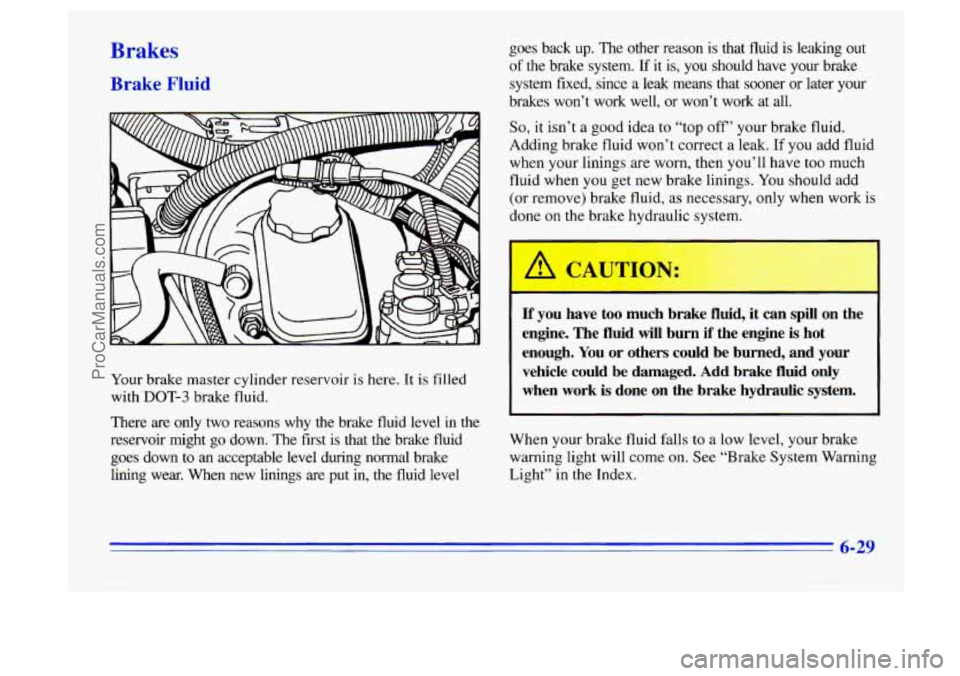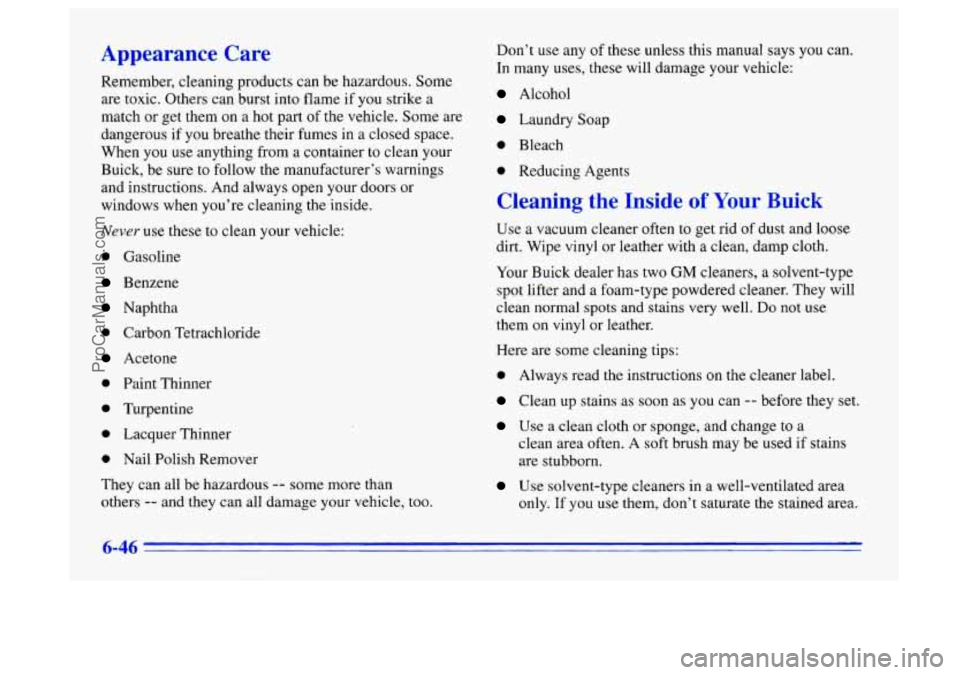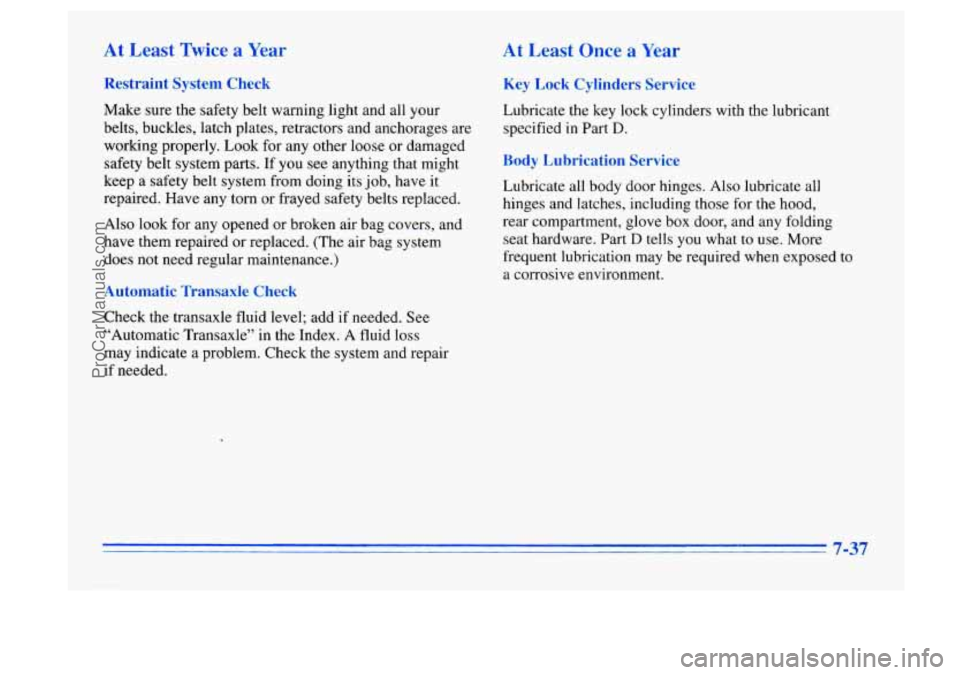1996 BUICK CENTURY warning
[x] Cancel search: warningPage 235 of 340

Brakes
Bra
Your brake master cylinder reservoir is here. It is filled
with
DOT-3 brake fluid.
There are
only two reasons why the brake fluid level in the
reservoir might go down. The first is that the brake fluid
goes down to an acceptable level during normal brake
lining wear. When new linings are put in, the fluid level goes
back up. The other reason is that fluid is leaking out
of the brake system. If it is, you should have your brake
system fixed, since a leak means that sooner or later your
brakes won’t work well, or won’t work at all.
So, it isn’t a good idea to “top off’ your brake fluid.
Adding brake fluid won’t correct a leak.
If you add fluid
when your linings are worn, then you’ll have too much
fluid when you get new brake linings.
You should add
(or remove) brake fluid,
as necessary, only when work is
done on the brake hydraulic system.
If you have too much brake fluid, it can spill on the
engine. The fluid
will burn if the engine is hot
enough. You or others could be burned, and your
vehicle could be damaged. Add brake fluid
only
when work is done on the brake hydraulic system.
When your brake fluid falls to a low level, your brake
warning light will come on.
See “Brake System Warning
Light”
in the Index.
ProCarManuals.com
Page 237 of 340

Brake Wear
Your Buick has front disc brakes and rear drum brakes.
Disc brake pads have built-in wear indicators that make a
high-pitched warning sound when the brake pads are worn
and new pads are needed.
The sound may come and go or
be heard all
the time your vehicle is moving (except when
you are pushing on the brake pedal firmly).
A CAUTION:
The brake wear warning sound means that
sooner or later your brakes won’t work well.
That could lead to an accident. When you hear
the brake wear warning sound, have your
vehicle serviced.
NOTICE:
Continuing to drive with worn-out brake pads
could result in costly brake repair.
Some driving conditions or climates may cause a brake
squeal when the brakes are first applied or lightly applied.
This does not mean something
is wrong with your brakes.
Fre’- -1ovement
of brake calipers and properly torqued
wheel nuts are necessary to help prevent brake
pulsation. When tires are rotated, inspect brake calipers
for movement, brake pads for wear, and evenly torque
wheel nuts
in the proper sequence to GM specifications.
Your rear drum brakes don’t have wear indicators, but
if
you ever hear a rear brake rubbing noise, have the rear
brake linings inspected.
Also, the rear brake drums should
be removed and inspected each time the tires are removed
for rotation or changing. When you have the front brakes
replaced, have
the rear brakes inspected, too.
Brake linings should always be replaced as complete
axle sets.
Brake Pedal Travel
See your dealer if the brake pedal does not return to
normal height, or if there is
a rapid increase in pedal
travel. This could be
a sign of brake trouble.
Brake Adjustment
Every time you apply the brakes, with or without the
vehicle moving, your brakes adjust for wear.
6-31
ProCarManuals.com
Page 249 of 340

Treadwear Temperature -- A, B, C
The treadwear grade is a comparative rating based on
the wear rate of the tire when tested under controlled
conditions on a specified government test course. For
example, a tire graded 150 would wear one and a half
(1 1/2) times as well on the government course as a tire
graded
100. The relative performance of tires depends
upon the actual conditions
of their use, however, and
may depart significantly from the norm due to variations
in driving habits, service practices and differences in
road characteristics and climate.
Traction -- A, B, C
The traction grades, from highest to lowest, are A, B, and
C, and they represent the tire’s ability to stop on wet
pavement as measured under controlled conditions on
specified government test surfaces of asphalt and concrete.
A tire marked C may have poor traction performance.
Warning: The traction grade assigned to this tire is based
on braking (straightahead) traction tests and does not
include cornering (turning) traction. The temperature grades are
A (the
highest), B, and C,
representing the tire’s resistance to the generation of
heat and its ability to dissipate heat when tested under
controlled conditions on a specified indoor laboratory
test wheel. Sustained high temperature can cause the
material of the tire to degenerate and reduce tire life, and
excessive temperature can lead to sudden tire failure.
The grade
C corresponds to a level of performance
which all passenger car tires must meet under the
Federal Motor Vehicle Safety Standard
No. 109. Grades
B and A represent higher levels of performance on the
laboratory test wheel than the minimum required by law.
Warning: The temperature grade for this tire
is
established for a tire that is properly inflated and not
overloaded. Excessive speed, underinflation, or
excessive loading, either separately or in combination,
can cause heat buildup and possible tire failure.
Wheel Alignment and Tire Balance
The wheels on your vehicle were aligned and balanced
carefully at the factory to give you the longest tire life
and best overall performance.
6-43
ProCarManuals.com
Page 252 of 340

Appearance Care
Remember, cleaning products can be hazardous. Some
are toxic. Others can burst into flame if you strike a
match or get them on a hot part
of the vehicle. Some are
dangerous
if you breathe their fumes in a closed space.
When you use anything from a container to clean your
Buick, be sure to follow the manufacturer’s warnings
and instructions. And always open your doors or
windows when you’re cleaning the inside.
Never use these to clean your vehicle:
0 Gasoline
Benzene
Naphtha
0 Carbon Tetrachloride
Acetone
0 Paint Thinner
0 Turpentine
0 Lacquer Thinner
0 Nail Polish Remover
They can all be hazardous
-- some more than
others
-- and they can all damage your vehicle, too. Don’t
use any of these unless this manual says
you can.
In many uses, these will damage your vehicle:
Alcohol
Laundry Soap
0 Bleach
0 Reducing Agents
Cleaning the Inside of Your Buick
Use a vacuum cleaner often to get rid of dust and loose
dirt. Wipe vinyl or leather with a clean, damp cloth.
Your Buick dealer has two GM cleaners, a solvent-type
spot lifter and a foam-type powdered cleaner. They will
clean normal spots and stains very well.
Do not use
them on vinyl or leather.
Here are some cleaning tips:
0 Always read the instructions on the cleaner label.
Clean up stains as soon as you can -- before they set.
Use a clean cloth or sponge, and change to a
clean area often. A soft brush may be used if stains
are stubborn.
Use solvent-type cleaners in a well-ventilated area
only. If you use them, don’t saturate the stained area.
6-46
ProCarManuals.com
Page 264 of 340

Fuse I qe Chart Fuse Circuitry
I----
ECM INJ/COIL UNLOCK FANiALT
GAUGES
STOP HAZ CTSY WDo
FRONT VIEW OF FUSE BLOCK
Fuse
ECM INJ/COIL
Circuitry
Powertrain Control Module Fuel Injectors UNLOCK Auto
Door Locks (Remove
this
fuse to disable the automatic
door unlock.)
FAN/ALT Electric Fan, Starter
and Generator, Seq. Fuel
Inj
(V6), Cruise Control,
Anti-Lock Brakes
TURN B/U Back-up Lamps
AIR BAG Supplemental Inflatable
Restraint (Air Bag System)
TAIL
HTR A/C
GAGES Taillamps,
Parking, Sidemarker,
License Plate, Stopflurn Signal
Heater/Air Conditioner
Blower Controls
IA? Cluster, Warning Indicators,
Torque Converter Clutch,
Audible Warning System, Trunk
Release, Brake Warning
Indicator, Rear Defog Switch,
Remote Keyless
Entry,
Headlamps, Air Bag System
6-58
ProCarManuals.com
Page 307 of 340

At Least Twice a Year
Restraint System Check
Make sure the safety belt warning light and all your
belts, buckles, latch plates, retractors and anchorages are
working properly. Look for any other loose or damaged
safety belt system parts. If you see anything that might
keep a safety belt system from doing its job, have it
repaired. Have any torn or frayed safety belts replaced.
Also look for
any opened or broken air bag covers, and
have them repaired or replaced. (The air bag system
does not need regular maintenance.)
Automatic Transaxle Check
Check the transaxle fluid level; add if needed. See
“Automatic Transaxle” in the Index. A fluid loss
may indicate a problem. Check the system and repair
if needed.
At Least Once a Year
Key Lock Cylinders Service
Lubricate the key lock cylinders with the lubricant
specified
in Part D.
Body Lubrication Service
Lubricate all body door hinges. Also lubricate all
hinges and latches, including those for the hood,
rear compartment, glove box door, and any folding
seat hardware. Part
D tells you what to use. More
frequent lubrication may be required when exposed to
a corrosive environment.
7-37
ProCarManuals.com
Page 329 of 340

Section 9 Index
Air Bag ...................................... I -2 1
How Does it Restrain .......................... 1-23
How it Works ................................ 1-22
Location
.................................... 1-22
Readiness Light
......................... 1-21? 2-49
Servicing
................................... 1-25
What Makes
it Inflate .......................... 2-23
What Will
You See After it Inflates ............... 1-24
When Should it Inflate
......................... 1-23
Aircleaner
.................................... 6-14
Air Conditioning
................................ 3-2
Air Conditioning Refrigerants
..................... 6-64
Alignment and Balance. Tire
...................... 6-43
Aluminum Wheels. Cleaning
...................... 6-5 I
Antenna. Fixed ................................. 3-10
Antifreeze
..................................... 6-22
Anti-Lock Brake System Active Light
................. 2-53. 4.8
Brake System Warning Light
................ 2-5 1. 4.6
Brakes
...................................... 4-6
Appearancecare
............................... 6-46
Appearance Care Materials
....................... 6-54
Arbitration Program
.............................. 8-6
Armrest. Storage
............................... 2-39
Ashtrays
...................................... 2-42 Audio
Equipment. Adding
......................... 3-9
Audio Systems
.................................. 3-4
Automatic Door Locks
............................ 2-4
Automatic Overdrive
............................ 2-17
Automatic Transaxle Check
....................... 7-38
Automatic Transaxle Fluid
........................ 6-17
Automatic Transaxle Operation
.................... 2-16
Shifting
..................................... 2-16
Automatic Transaxle Park Mechanism Check
......... 7-40
Battery
...................................... 6.3 2
Jump Starting
................................. 5-2
Warning Light
............................... 2-50
Warnings
................................ 5.2. 5.4
BBB Auto Line ................................. 8-6
Better Business Bureau Mediation
................... 8-6
Brake Replacement.
Remote Keyless Entry
............... 2-6
Adjustment
.................................. 6-31
Fluid
....................................... 6-29
Master Cylinder
.............................. 6-29
Parking
..................................... 2-19
PedalTravel
................................. 6-31
Replacing System Parts
........................ 6-32
System Warning Light
......................... 2-50
9-1
ProCarManuals.com
Page 331 of 340

Cruise Control .................................. 2-30
Cupholders
.................................... 2-39
Customer Assistance Information
................... 8- 1
Customer Satisfaction Procedure .................... 8- 1
Damage. Finish ............................... 6-52
Damage. Sheet Metal
............................ 6-52
Daytime Running Lamps
......................... 2-34
Dead Battery
................................... 5-2
Defects. Reporting Safety
......................... 8-7
Defensive Driving
............................... 4- 1
Defogger. Rear Window
.......................... 3-3
Defogging
..................................... 3-2
Defrosting
..................................... 3-2
Dimensions. Vehicle
............................ 6-63
Door
Drive Position. Automatic Transaxle
................ 2- 18
Driver Position
................................. 1 - 13
Driving
City
....................................... 4-19
Defensive
.................................... 4-1
Drunken
..................................... 4-2
Freeway
.................................... 4-20
In a Blizzard ................................. 4-26
In Foreign Countries
........................... 6-4
IntheRain
.................................. 4-16
Night
...................................... 4-14
OnCurves
................................... 4-9
On Grades While Towing a Trailer ............... 4-35
On Hill and Mountain Roads
.................... 4-22
Customer Assistance for
Text Telephone Users
......... 8-3
Locks
....................................... 2-3 OnSnowandIce
............................. 4-25
Wet Roads
.................................. 4-16
Winter ...................................... 4-24
With a Trailer
................................ 4-34
DrunkenDriving
................................ 4-2
Electrical Equipment. Adding
................ 3-9. 6-56
Electrical System
............................... 6-56
Engine 6-8. 6-9
Engine
Coolant
..................................... 6-22
Coolant Heater
............................... 2-14
Coolant Level Check
.......................... 7-37
Coolant Temperature Gage
..................... 2-54
Exhaust
..................................... 2-24
Identification
................................ 6-55
OilLevelCheck
.............................. 7-37
Overheating
................................. 5-13
Running While Parked ......................... 2-24
Specifications
................................ 6-63
Starting Your
........................... 2- 12. 2-13
Engineoil
.................................... 6-10
Adding
..................................... 6-12
Additives
................................... 6-13
Checking
................................... 6-10
Used
....................................... 6-14
Whentochange
.............................. 6-14
Engine
Oil Pressure Light ........................ 2-57
Ethanol
........................................ 6-3
Through Deep Standing
Water
................... 4-18
Coolant Temperature Warning Light
.............. 2-53
Exhaust. Engine
................................ 2-24
9-3
ProCarManuals.com